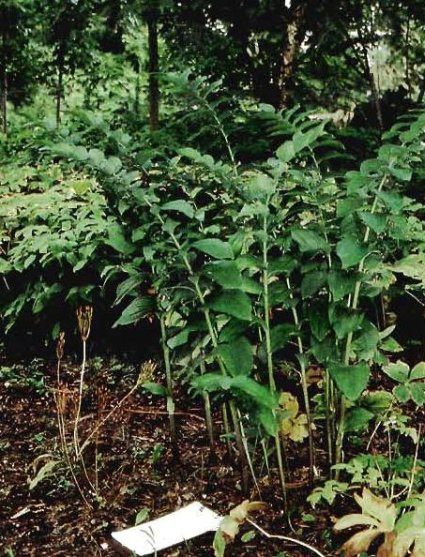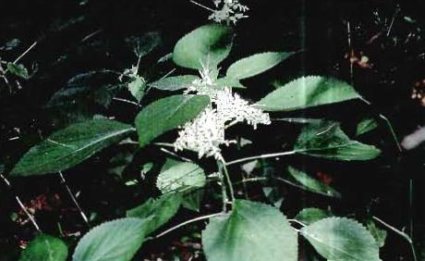
This is the fourth of a series of posts that will cover the "Top 100" forest garden plants taken from volume 1 of the Edible Forest Gardens books. In this post we start our list of running herbs.

Giant Solomon's Seal - Polygonatum biflorum var. commutatum
Hardiness zone 3, full sun to part shade, running, 3-5 ft. x indefinitely spreading, edible shoots (image above)
This beautiful, native wildflower of the lily family sends up slender 3 to 5 foot (0.9 to 1.6 m) stalks in drifts and spreads by rhizomes. It is commendable for its adaptability—giant Solomon's seal grows in full sun all the way to full shade. Cut and use its edible shoots in the spring, like asparagus; they taste quite good, though the leaf cluster at the top of the shoot may taste somewhat bitter. Giant Solomon's seal is another example of an underutilized native that is highly adapted to the forest garden model.
Ostrich Fern - Matteuccia struthiopteris
Hardiness zone 2, part to full shade, running, 4-6 ft. x indefinitely spreading, edible shoots
Each spring, markets in New England offer the strange, tightly curled shoots of ostrich fern, known as fiddleheads. This is one of the most well-known and beloved native wild edibles of the eastern forest. It is also an attractive ornamental, reaching 4 to 6 feet (1.2 to 1.8 m) or more and forming extensive colonies in moist soil and part to full shade. The distance between crowns leaves room for low-growing, shade-tolerant companions. Steam or boil the fiddleheads for at least ten minutes to remove toxins. They taste delicious when boiled and served with butter.
Mints - Mentha spp.
Hardiness zone 3, full sun to part shade, running, 1-3 ft. x indefinitely spreading, edible tea, culinary, aromatic
The numerous species and hybrids of mint are highly adapted for the forest garden. They were among the most prevalent understory species in Robert Hart's garden. Unfortunately, as he was quick to admit, they were among the more troublesome weeds in his garden as well. Mints tend to be vigorous runners, colonizing new areas but never staying in one area for too many years. They will outcompete many other herbs, except for large, tough, well-established dumpers. Their foliage is wonderful in teas, fresh or dried, and in small amounts in salads. The flowers are excellent generalist nectaries, attracting many beneficial insects, and the strong scent of the foliage confuses pests in their search for their favorite foods. A new cultivar called 'Marilyn's Salad Mint' is said to have milder-flavored leaves and is a promising new running perennial vegetable for partial shade.
Chinese Artichoke - Stachys affinis
Hardiness zone 5, full sun to part shade, running, 18 in. x indefinitely spreading, edible tubers
This running ground cover is in the mint family. It is native to eastern Asia, but people now grow it throughout the cold climates of the world. It produces small (1 inch/3 cm) tubers, in good quantity. The tubers are crisp, with a light mint flavor, but they are also bumpy and somewhat difficult to clean. They taste good raw in salads and can be cooked in a variety of ways. Chinese artichoke makes a moderately dense cover. Annual harvest results in higher yields. Harvest all you can find, because enough will always elude discovery to ensure a vigorous stand the following year.
NETTLES (Laportaea AND Urtica SPP.)
Wood Nettle - Laportaea canadensis
Hardiness zone 3, part to full shade, running, 1-3 ft. x indefinitely spreading, edible leaves (image below)
Stinging Nettle - Urtica dioica
Hardiness zone 4, full sun to part shade, running, 3-4 ft. x indefinitely spreading, edible leaves, dynamic accumulator
Nettles in a forest garden? Why would we welcome a plant that causes painful stings? Believe it or not, nettles are among the most beneficial plants for the forest garden. For starters, both of these closely related species produce delicious and hearty greens—when cooked (make sure to harvest with gloves on). Even a minute of steaming is enough to deactivate the sting. If you have never had them, the delightful taste of the greens will surprise you. Both plants form large colonies through seed and rhizomes. Use rhizome barriers, and be sure to locate your nettles where you will not accidentally brush against them.
Stinging nettle is one of the most nutritious leafy greens in the world, as well as being a fabulous dynamic accumulator and a wonderful compost plant. Research indicates that it increases the volatile oil content of herbs grown alongside it, making them more aromatic. Stinging nettles have naturalized in most of the United States, often in situations closely resembling forest gardens. The variety gracilis is native to North America. Our native wood nettle is also a delicious potherb and may be a dynamic accumulator like its cousin. Wood nettle grows in full shade and seems to thrive in the understory of old-growth forests.



No comments:
Post a Comment